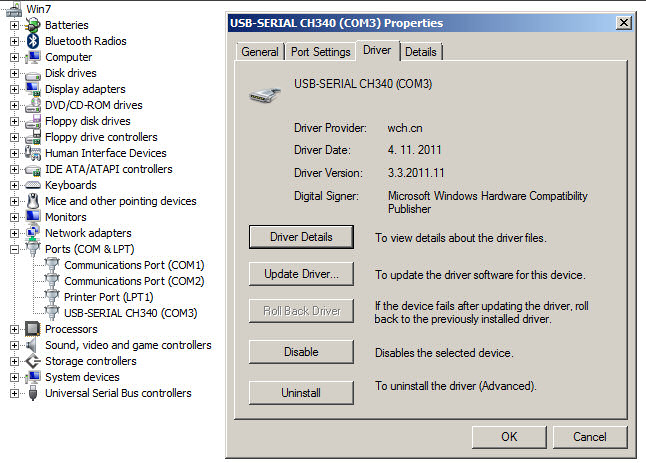
Martin hey guys does anyone know why this is everything is hooked up?? Sketch uses 1,030 bytes (7%) of program storage space. Maximum is 14,336 bytes. Global variables use 9 bytes (0%) of dynamic memory, leaving 1,015 bytes for local variables. Maximum is 1,024 bytes. Ian Culley Thank you greatly for this solution, it works.
I run Windows 7 64 bit and was trying for 5 hours (embarrassingly so) to communicate with an Arduino Nano V3.0 purchased on line before I discovered this post. The trap for young players was not looking specifically at/or identifying the USB comm’s chip on the board earlier on. I fell for the surf the net here is the recommended solution for you. As soon as I had retraced my steps all the way back to the start and Identified the WCH340G chip is used for the comms I was straight onto this web page and downloaded the driver software. Following installation I was able to communicate with the nano and write code to it. I am using a USB cable from a cannon camera that I bought in 2004. As a further test I changed the delay time on the ‘blink’ code and uploaded it to the nano.
Talking Caller ID Hear who’s calling from across the room. This not only extends available talk time but also prolongs battery life. Intelligent Eco Mode With the Intelligent Eco Mode, when you use the handset closest to the base unit, you’ll automatically lower power consumption. The Talking Caller ID feature uses text-to-speech technology, announcing the caller’s information in between rings. 
Install wch.cn USB-SERIAL CH340 driver for Windows 7 x64, or download DriverPack Solution software for automatic driver installation and update. Programma julivi clo 3d na russkom free. 'This came from the driver CD that came with a cheap CH341 based USB to Serial adapter that had numerous other drivers on the CD as well. This is the correct driver for the serial adapter, and it includes drivers for Windows 7 x64. It also seems to have drivers for Windows 98, 2000, XP, 2003, Vista, and.' Arduino CH340 Driver Arduino LLC.
So thank you very very much. Randy Moore I have also found that these drivers work fine when connecting the LoLin NodeMCU V3 to my Windows 7 PC (I had to do nothing, since I had already loaded the drivers for my cheap Chinese Arduino Nano clones). I suspect the same will be true for the Amica v0.9 (yellow or blue PCB) NodeMCUs (both considered out-dated) and the DoIt/SmartArduino brand NodeMCU V2. Both of these boards also use a WCH CH340G USB-to-UART bridge chip. As an Arduino-phil I use the ESP8266 Core from GitHub to adapt the Arduino IDE to the ESP8266. It uses a somewhat different tool chain to compile the Arduino C code into binary files executable by the ESP8266, but the Arduino IDE and most libraries are the same.

The only stumbling points are: 1.) The NODEMCU “Arduino friendly” pin names (D0 thru D8, plus RX and TX) don’t correspond with the actual ESP8266 GPIO pin numbers, so you have to make special arrangements to map the “D1”, “D2”, etc names to the actual GPIO pin numbers. There are a few ways to do this. 2.) There is only one ADC on the ESP8266, 3.) The board, like the Arduino Due is a 3.3V system, so things like voltage divider resistors, bidirectional level circuits (or modules) usually based on FETs, and other tricks are required to match voltage levels, especially the 5V outputs of TTL chips leading to the 3.3V inputs of the ESP8266.
